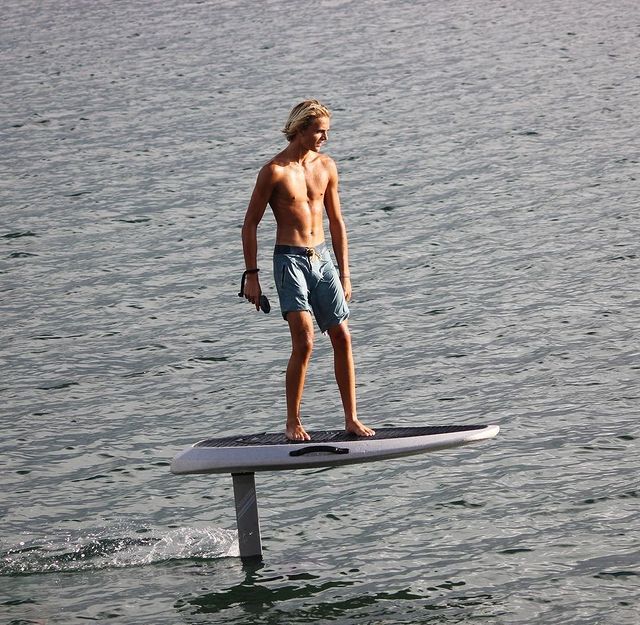Address
304 North Cardinal
St. Dorchester Center, MA 02124
Work Hours
Monday to Friday: 7AM - 7PM
Weekend: 10AM - 5PM
Address
304 North Cardinal
St. Dorchester Center, MA 02124
Work Hours
Monday to Friday: 7AM - 7PM
Weekend: 10AM - 5PM

What can you do with 2 kWh? do you know? How much is 2 kWh? 2 kWh of electricity can work for 20 minutes for a 6kWh electric water heater; 2 kWh of electricity can only charge an electric car with a charging power of 60kWh for 2 minutes; 2 kWh of electricity is only enough for a 600kWh generator to generate electricity for 20 seconds; however, 2 kWh of electricity can Let you successfully cross the Qiongzhou Strait with a width of about 30 kilometers from north to south.
In simple terms, 1 kWh is the power consumed by an electrical appliance with a power of 1000W for one hour of operation.
Crossing the Qiongzhou Strait, Aaron, the challenger, stepped on the Waydoo Flyer ONE electric hydrofoil surfboard on the sea surface and moved forward at a constant speed of 30km/h, and the energy consumption per hour could be reduced to less than 2000W, which means that only 2 degrees Electricity can travel at least 30km, just close to the distance of Qiongzhou Strait

So how does the Waydoo Flyer ONE electric hydrofoil surfboard accomplish the challenge of crossing the Qiongzhou Strait while only consuming 2 kWh of electricity?
This is to mention the efficient hydrofoil and power system of the surfboard! We know that when moving in a fluid to obtain lift, it is bound to pay the price of resistance. In ordinary vehicles such as speedboats and motorboats, the dynamic principle is that the sliding surface will generate lift when moving on water, but the lift-to-drag ratio of the sliding surface is usually no more than 4.
The dynamic principle of hydrofoils moving underwater is completely different. Hydrofoils are similar to aircraft wings and are one of the most efficient fluid machines. After the optimized two-dimensional airfoil, the maximum lift-drag ratio can reach more than 100, which is reasonable. The designed three-dimensional wing cruise lift-drag ratio can often reach more than 10. So this means that at the same speed, the energy consumption of hydrofoils will be reduced by more than half compared to ordinary vehicles. Not only that, the wave resistance of hydrofoils is much higher than that of the gliding surface. When the object is moving underwater, the wave influence decreases exponentially with the increase of depth.
Secondly, the efficient power system of the Waydoo Flyer ONE electric hydrofoil surfboard is the key to the successful crossing of the Qiongzhou Strait!
The R&D team has carried out refined design and optimization of the propeller. From the determination of one-dimensional parameters to the optimization of two-dimensional pitch and disk surface ratio to the large-scale calculation of three-dimensional propeller CFD, we have used professional technology to carry out the whole process. the design of.

This involves a large number of leading design technologies and calculation methods: first, the first round of rapid theoretical calculation of the propeller shape is carried out by using the lift line theory and the panel method, and the genetic algorithm is used for screening, and then by solving the three-dimensional Navier-Stocks equations The theoretical propeller type is subjected to high-precision numerical simulation and further optimization, and finally, a propeller with excellent performance is obtained through repeated actual flight test flights.
The duct of the propeller is not only a protective device, but its implied function is more important, that is, to provide some additional thrust by using the combined action of the anti-airfoil and the slipstream of the propeller. The duct profile is also an airfoil, but it is inverted. The propeller accelerates the flow on the inner surface of the duct, making the inner surface faster. According to Bernoulli’s principle, the airfoil will be subjected to inward pressure. Set at a reasonable angle, the pressure on all the airfoils on the duct creates a forward resultant force, further improving the efficiency of the propulsion system. After the above efforts, the cruising efficiency of the Weidu propulsion system can reach 80%.
Based on the above two points, it can help you better understand why the Waydoo Flyer ONE electric eFoil surfboard is used to cross the Qiongzhou Strait, which is about 30 kilometers wide from north to south, and only consumes two kWh of electricity.